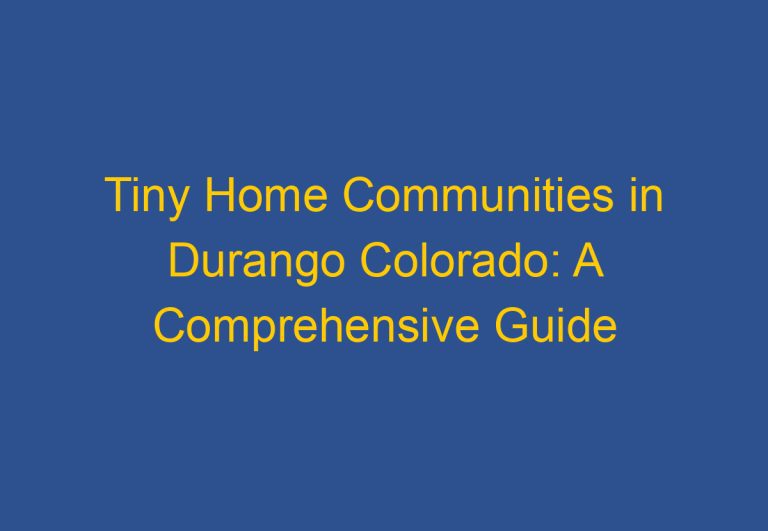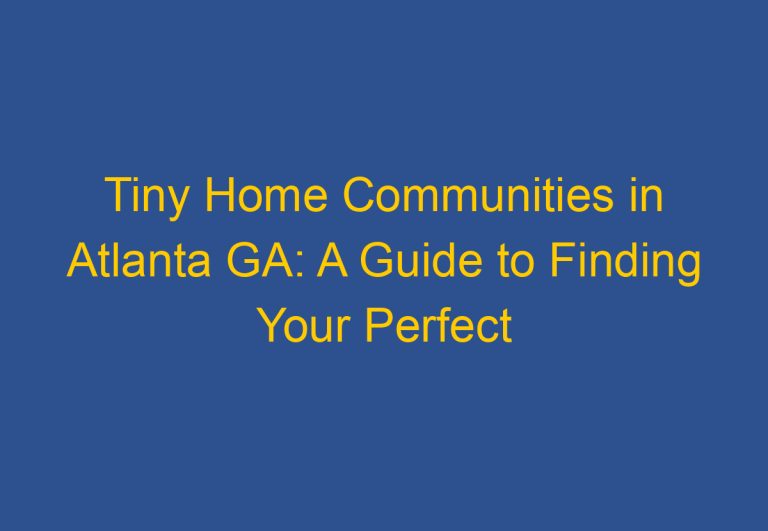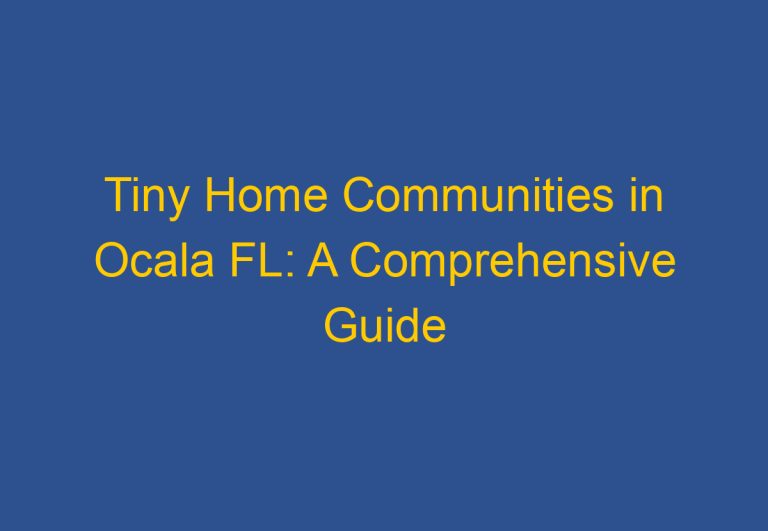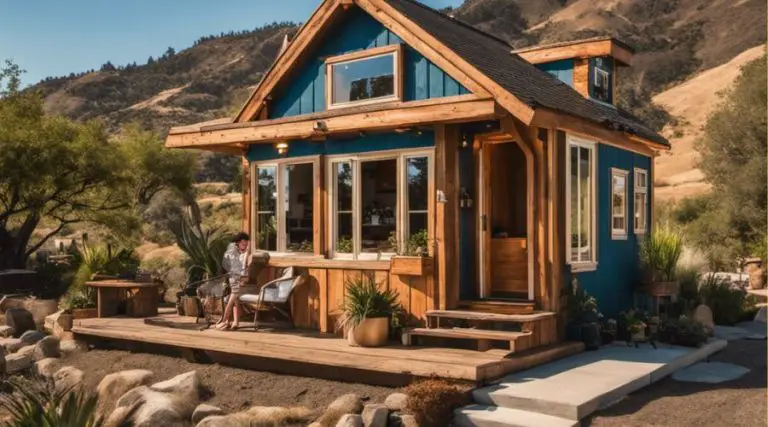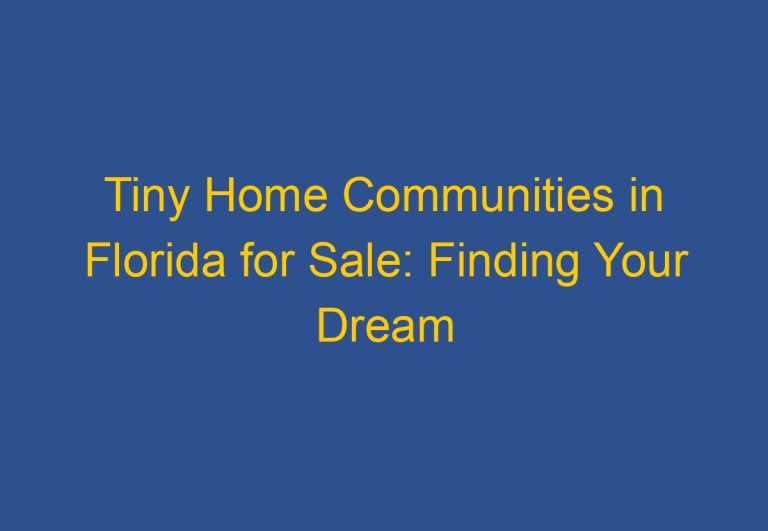Tiny Home Communities in Central Florida: A Guide to Finding Your Ideal Living Space
Tiny homes have been gaining popularity in recent years as a more sustainable and affordable housing option. Central Florida is no exception, with several communities dedicated to tiny home living. These communities offer a unique lifestyle that emphasizes minimalism, community, and environmental consciousness.
One such community is the Glenwood Cove, located near Gainesville, Florida. It features a selection of tiny homes, from rustic cabins to modern dwellings. Residents can enjoy a variety of amenities, including a pool, a clubhouse, and a selection of outdoor activities. Another option is The Preserve, a new 10-space tiny house community in Central Florida. Part of The Outpost RV Resort development on beautiful 500-acre Lake Mariana, it is located in Winter Haven, a short drive from Lakeland, Orlando, Tampa, and more. As a resident of The Preserve, you can enjoy beautiful park-like settings and a sense of community with like-minded individuals.
Other tiny home communities in Central Florida include the Orlando Lakefront at College Park, which offers lakefront living in the heart of Orlando, and the Natura Preserve, located in the Ocala National Forest. These communities offer a unique way of life that is becoming increasingly popular in Central Florida.
Understanding Tiny Home Communities in Central Florida
Central Florida is a great place to live in a tiny home community. Tiny living is a lifestyle that is becoming increasingly popular, and for good reason. It allows individuals to live a minimalist lifestyle while enjoying the benefits of community living. In this section, we will explore the benefits of tiny living and the legal landscape and zoning regulations surrounding tiny home communities in Central Florida.
Benefits of Tiny Living
One of the biggest benefits of tiny living is the cost savings. Tiny homes are much cheaper than traditional homes, and they require less maintenance. They are also more energy-efficient, which means lower utility bills. Additionally, tiny living allows individuals to live a more sustainable lifestyle, as they use fewer resources and produce less waste.
Another benefit of tiny living is the sense of community. Tiny home communities are designed to foster a sense of community and belonging. Residents often share common spaces and amenities, which encourages social interaction and a sense of community.
Legal Landscape and Zoning Regulations
When it comes to tiny home communities in Central Florida, it’s important to understand the legal landscape and zoning regulations. While the state of Florida is generally considered to be “tiny house friendly,” there are still zoning regulations that must be followed.
In general, tiny homes must be legally parked on a property that is zoned for residential use. The property owner must obtain the necessary permits and follow all building codes. Additionally, some counties and municipalities have specific regulations regarding tiny homes, so it’s important to research the local laws before purchasing a tiny home or joining a tiny home community.
In conclusion, tiny home communities in Central Florida offer a unique and affordable way to live a minimalist lifestyle while enjoying the benefits of community living. By understanding the benefits of tiny living and the legal landscape and zoning regulations, individuals can make informed decisions about whether a tiny home community is right for them.
Popular Tiny Home Communities
Central Florida is home to several tiny home communities that offer an affordable and eco-friendly lifestyle. Here are a few of the most popular tiny home communities in the area:
Orlando Lakefront Tiny Home Community
Located in Orlando, the Orlando Lakefront Tiny Home Community is a popular destination for those seeking a minimalist lifestyle. The community features over 30 tiny homes, each with its unique design and layout. The community’s location on the shores of Lake Fairview provides residents with stunning views and easy access to water activities.
Circle Pond Tiny Home Community
Circle Pond Tiny Home Community is a tiny home community located in Hillsborough County, Florida. The community features several tiny homes, each with its unique design and layout. The community is situated on a beautiful lake, providing residents with stunning views and easy access to water activities.
Tampa Bay Village
Tampa Bay Village is a tiny home community located in Tampa, Florida. The community features several tiny homes, each with its unique design and layout. The community is situated on a beautiful lake, providing residents with stunning views and easy access to water activities. The community is also conveniently located near several shops, restaurants, and other amenities.
Gracious Tiny House Park
Gracious Tiny House Park is a tiny home community located in Sarasota, Florida. The community features several tiny homes, each with its unique design and layout. The community is situated on a beautiful lake, providing residents with stunning views and easy access to water activities. The community is also conveniently located near several shops, restaurants, and other amenities.
Overall, Central Florida is a great place to live if you’re interested in the tiny home lifestyle. With several communities to choose from, you’re sure to find a community that suits your needs and preferences.
Amenities and Lifestyle
Community Features and Recreation
Central Florida’s tiny home communities offer a range of amenities and recreational opportunities for residents. Many communities have community pools, fitness facilities, and fire pits, which provide opportunities for residents to socialize and stay active. Some communities even have observation decks, which offer stunning views of the surrounding area.
In addition to these amenities, many communities also offer a sense of community, which is important for many tiny home residents. The community setting allows residents to form strong bonds with their neighbors, and many communities have events and activities that encourage residents to come together.
Sustainability and Eco-Friendly Practices
Many of the tiny home communities in Central Florida are committed to sustainability and eco-friendly practices. Some communities use solar panels to generate electricity, while others use rainwater collection systems to reduce water usage. Many communities also have community gardens, which provide residents with fresh produce and help to reduce the community’s carbon footprint.
Residents of these communities are also encouraged to adopt sustainable practices, such as composting and recycling. Many communities have recycling centers on site, and some even offer classes and workshops on sustainable living.
Overall, the tiny home communities in Central Florida offer a modern and sustainable way of living that is attractive to many people. The communities provide residents with a sense of community and a range of amenities and recreational opportunities, while also encouraging sustainable practices and reducing their carbon footprint.
Costs and Considerations
Ownership and Lot Rent
When it comes to owning a tiny home in a community, there are a few costs and considerations to keep in mind. First and foremost is the cost of the home itself. Depending on the size, style, and amenities, a tiny home can cost anywhere from $30,000 to $100,000 or more. It’s important to do your research and find a model that fits your budget and lifestyle.
In addition to the cost of the home, you’ll also need to consider lot rent. Most tiny home communities charge a monthly lot rent fee, which can range from $350 to $1,000 or more depending on the location and amenities. Some communities may also require an upfront deposit or application fee.
Utility Hookups and Maintenance
Another cost to consider is utility hookups and maintenance. Most tiny homes require electric, water, and sewer hookups, which can add up over time. It’s important to check with the community to see what utilities are included in the lot rent and what you’ll need to pay for separately.
Maintenance is also an important consideration. While tiny homes are often simpler and easier to maintain than traditional homes, they still require upkeep. This can include everything from basic cleaning and repairs to more complex tasks like roof maintenance and pest control.
Overall, owning a tiny home in a community can be an affordable and rewarding option for those looking to simplify their lives and embrace a more sustainable lifestyle. With careful planning and research, you can find a community that fits your budget and meets your needs.
Frequently Asked Questions
What are the best-rated tiny home communities in Central Florida?
Some of the best-rated tiny home communities in Central Florida include Green Park, Lake Weir Preserve, and Wildwood Lakefront Cottages. These communities offer a range of amenities and are located in beautiful natural settings.
Where can I find tiny homes for sale in Central Florida?
You can find tiny homes for sale in Central Florida by searching online real estate marketplaces, such as Zillow or Realtor.com. You can also visit tiny home communities and inquire about available homes for sale.
Are there affordable tiny home communities located in Central Florida?
Yes, there are affordable tiny home communities located in Central Florida. Some of these communities offer homes for sale or rent at prices that are comparable to or lower than traditional homes or apartments in the area.
Can I rent a tiny home in a Central Florida community, and how do I find listings?
Yes, you can rent a tiny home in a Central Florida community. You can find listings for rental homes in tiny home communities by searching online rental marketplaces or contacting the communities directly.
What are the latest developments in new tiny home communities in Florida?
There are several new tiny home communities being developed in Florida, including Lake Weir Preserve and Wildwood Lakefront Cottages. These communities offer a range of amenities and are located in beautiful natural settings.
What regulations should I be aware of when placing a tiny house on land in Florida?
When placing a tiny house on land in Florida, it is important to be aware of local zoning and building codes. Some counties and municipalities have specific regulations regarding the size and placement of tiny homes. It is important to research these regulations and obtain any necessary permits before placing a tiny home on land in Florida.







